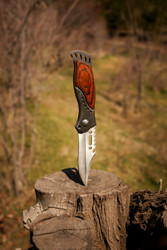Unlocking the Secrets of the Folding Knife
18th Feb 2024
Folding knives, with their blend of practicality and craftsmanship, have captivated the hearts of many. From the classic pocket knife to the modern tactical folder, these tools are as versatile as they are portable. Whether you're a seasoned collector or a newcomer to the world of knives, understanding how to care for, use, and appreciate your folding knife is essential. This guide will walk you through everything from the basics of folding knives to maintenance tips and legal considerations.
What Is a Folding Knife?
A folding knife, as the name suggests, features a blade that folds into the handle, making it compact and safe to carry. Unlike fixed blade knives, which are always exposed, folding knives offer the convenience of portability without sacrificing utility. They come in various styles, each suited to different tasks and preferences.
Parts of a Folding Knife
To fully appreciate and maintain your knife, it's crucial to understand its components. A typical folding knife includes:
- Blade: The cutting part of the knife, which can be made from various materials and come in different shapes.
- Handle: The part you hold, which houses the blade when it's folded.
- Lock: A mechanism that secures the blade in the open or closed position to ensure safety.
- Pivot: The point around which the blade rotates.
Folding Knife Styles
Folding knives vary widely in design, from the traditional slip joint to the modern frame lock. One notable style is the friction folder knife, which relies on friction between the handle and the blade to stay open or closed, lacking a dedicated locking mechanism.
Using Your Folding Knife Safely
How to Open a Folding Knife?
Gently apply pressure to the thumb stud or nail nick to swing the blade open, ensuring your fingers are clear of the blade's path.
How to Fold a Pocket Knife?
Press down on the lock mechanism (if present) and carefully rotate the blade back into the handle until it snaps shut.
Maintenance Tips
- How to Clean a Folding Knife: Disassemble (if possible) and use mild soap and water to clean the parts. Dry thoroughly to prevent rust.
- Sharpening Your Knife: Use a stone to maintain the edge. Start with coarser grits for dull blades and finish with finer grits for a sharp edge.
- Fixing a Loose Blade: Tighten the pivot screw if your knife blade becomes loose. If the problem persists, consult the manufacturer or a professional.
Legal Considerations
- Carrying a Folding Knife: Laws vary by location. In many places, it's legal to carry a folding knife with certain blade length restrictions. Always check local laws to ensure compliance.
- Specific Regulations: For example, in Michigan, you can carry a folding knife, but there may be restrictions based on blade length or the type of knife.
Conclusion
Folding knives are more than just tools; they are a testament to human ingenuity and a companion for everyday challenges. Whether you're opening packages, preparing a campsite, or simply admiring the craftsmanship of your latest acquisition, understanding how to use, maintain, and respect your folding knife ensures it will serve you well for years to come.


 Gift Cards
Gift Cards